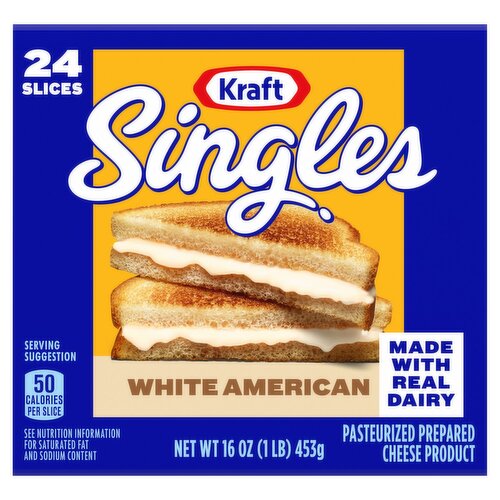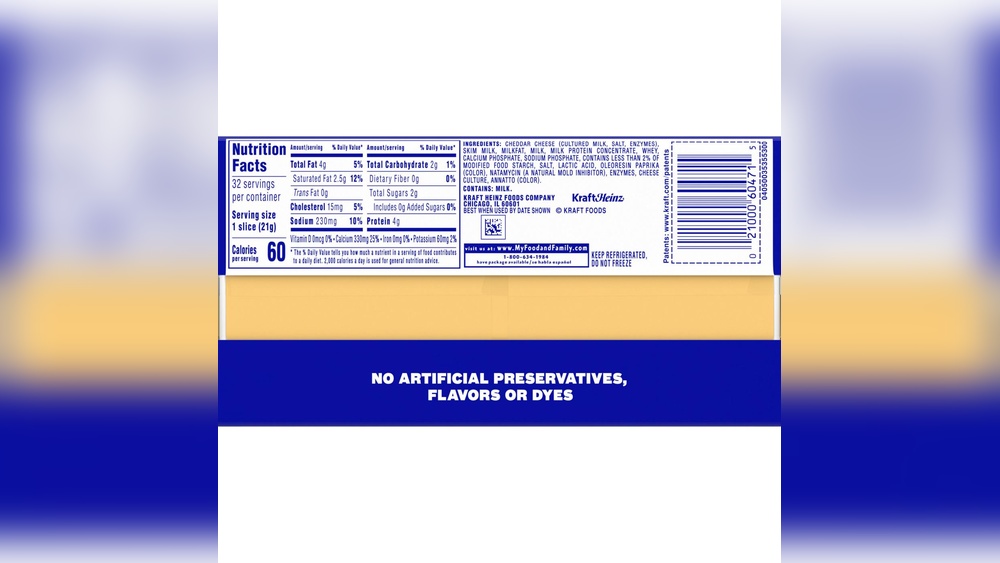Are you curious about what’s really inside those Kraft Cheese Slices you enjoy? Understanding the nutritional information can help you make smarter choices for your health and diet.
Whether you’re watching your calories, managing your fat intake, or just want to know what fuels your body, this guide will give you clear and simple facts. Keep reading to discover everything you need to know about Kraft Cheese Slices and how they fit into your daily nutrition.

Credit: foodlion.com
Nutritional Profile
The nutritional profile of Kraft Cheese Slices reveals important information about its content. Understanding this helps you make better food choices. Each slice offers a mix of calories, macronutrients, vitamins, and minerals.
This section breaks down the key nutrients in Kraft Cheese Slices. It shows what you get in each serving. Knowing these details supports a balanced diet and healthy eating habits.
Calories And Serving Size
Each Kraft Cheese Slice contains about 60 calories. The serving size is one slice, roughly 21 grams. This portion is easy to measure and use in meals. The calorie count is moderate for a cheese product.
Macronutrients Breakdown
Kraft Cheese Slices have 4.5 grams of fat per slice. Of these fats, about 3 grams are saturated fats. Protein content is 4 grams, supporting muscle health. Carbohydrates are very low, usually under 2 grams per slice. This makes it suitable for low-carb diets.
Vitamins And Minerals
These cheese slices contain calcium, essential for bones. One slice provides about 15% of the daily calcium need. It also offers small amounts of vitamin A, which helps vision. Sodium is present at around 280 mg per slice. This is a factor to watch in salt intake.
Ingredients And Additives
Kraft Cheese Slices contain a mix of ingredients and additives. These components help keep the cheese fresh and tasty. Understanding them helps you know what you eat. This section breaks down the main ingredients and common additives found in Kraft Cheese Slices.
Key Ingredients Used
The main ingredient is pasteurized milk. It provides the base for the cheese. Other key ingredients include whey protein concentrate and milk protein concentrate. These add protein and improve texture.
Cheese culture is added to develop flavor. Salt enhances the taste and acts as a preservative. Enzymes help in the cheese-making process. They give the cheese its smooth texture.
Common Additives Explained
Emulsifiers keep the cheese slices from separating. Sodium citrate and sodium phosphate are two common emulsifiers. They make the cheese melt evenly and stay creamy.
Preservatives like sorbic acid prevent mold growth. This keeps the cheese safe to eat longer. Coloring agents such as annatto give the cheese its yellow color. These additives do not affect taste but improve appearance.
Health Benefits
Kraft Cheese Slices offer several health benefits through their key nutrients. These slices provide important elements that support daily body functions. Understanding their nutritional value helps make better food choices.
Below are the main health benefits of Kraft Cheese Slices.
Protein Contribution
Kraft Cheese Slices contain a good amount of protein. Protein helps build and repair muscles and tissues. It supports the immune system and keeps you full longer. Including these cheese slices can add valuable protein to meals and snacks.
Calcium And Bone Health
Calcium is a major mineral in Kraft Cheese Slices. Calcium strengthens bones and teeth. It helps prevent bone diseases like osteoporosis. Eating cheese slices regularly supports healthy bone growth and maintenance. This is important for children, adults, and seniors alike.
Other Nutrient Benefits
Kraft Cheese Slices contain vitamins A and B12. Vitamin A helps keep eyes and skin healthy. Vitamin B12 supports brain function and energy levels. The slices also have minerals like phosphorus and zinc. These nutrients contribute to overall health and well-being.
Credit: www.thefreshgrocer.com
Potential Drawbacks
Kraft Cheese Slices offer convenience and taste. Still, some nutritional aspects might concern health-conscious people. Knowing these potential drawbacks helps make better food choices.
Sodium Content
Kraft Cheese Slices contain a notable amount of sodium. High sodium intake can raise blood pressure. People watching their salt intake should be cautious. One slice may have over 200 mg of sodium. Eating many slices quickly adds up the salt.
Fat And Cholesterol Levels
These cheese slices have moderate fat and cholesterol. Saturated fat is present, which affects heart health. Consuming large amounts may increase cholesterol levels. Those with heart issues should limit intake. Balancing with low-fat foods is wise.
Allergen Information
Kraft Cheese Slices contain milk, a common allergen. People with lactose intolerance or dairy allergies should avoid them. Cross-contamination risks exist for sensitive individuals. Checking labels before eating is important. Alternatives without dairy suit those with allergies better.
Comparing Kraft Cheese Slices
Kraft cheese slices are popular for sandwiches and snacks. Many people wonder which type fits their diet best. Comparing different Kraft cheese slices helps make a better choice. Each type has unique features and nutrition facts. Understanding these differences aids in picking the right option for health and taste.
Below, we compare Kraft cheese slices by fat content and type of cheese. This makes it easier to see how they differ in calories, fat, and flavor.
Original Vs Reduced Fat
Original Kraft cheese slices have more fat and calories. This gives them a creamier taste and texture. Reduced fat slices have less fat and fewer calories. They suit people who want to cut down fat intake. Reduced fat slices may taste less rich but still melt well. Both types provide protein and calcium. Choosing depends on your diet needs and flavor preference.
Processed Vs Natural Cheese
Kraft cheese slices are mostly processed cheese. Processed cheese uses cheese, milk, and emulsifiers. It melts smoothly and lasts longer. Natural cheese is made from milk and cultures only. It has a stronger flavor and firmer texture. Processed cheese slices often have added salt and preservatives. Natural cheese is simpler and may have more nutrients. Each type suits different recipes and tastes.

Credit: www.thefreshgrocer.com
Tips For Incorporating Cheese
Cheese adds flavor and texture to many meals. Kraft Cheese Slices are easy to use in daily cooking. Knowing how to include them smartly keeps meals tasty and balanced. Small changes can improve nutrition without losing taste.
Balanced Serving Suggestions
Use one or two slices per serving. This controls calories and fat intake. Melt slices on sandwiches or burgers for quick meals. Add slices to scrambled eggs for extra protein. Avoid using large amounts to keep meals healthy. Portion control helps enjoy cheese without overdoing it.
Pairing With Healthy Foods
Pair cheese with fresh vegetables like tomatoes or cucumbers. Use cheese slices in wraps with leafy greens and lean meats. Combine with whole grain bread for more fiber. Cheese pairs well with fruits like apples or pears. These combos boost vitamins and minerals. They balance fats and add crunch and sweetness.
Frequently Asked Questions
What Are The Calories In Kraft Cheese Slices?
Each Kraft cheese slice contains approximately 60 calories. This makes it a moderate-calorie option for sandwiches and snacks.
How Much Protein Is In Kraft Cheese Slices?
One Kraft cheese slice provides about 4 grams of protein. Protein supports muscle growth and keeps you feeling full longer.
Are Kraft Cheese Slices High In Sodium?
Yes, each slice contains around 270 mg of sodium. It’s important to monitor intake if you are watching your salt consumption.
What Vitamins And Minerals Are In Kraft Cheese Slices?
Kraft cheese slices offer calcium and vitamin A. These nutrients help support bone health and vision.
Conclusion
Kraft cheese slices offer a tasty, convenient option for meals. They provide protein and calcium but contain some fat and sodium. Knowing the nutrition helps you make smart choices every day. Enjoy Kraft cheese slices in sandwiches or snacks with balance.
Keep portion sizes in mind to stay healthy and satisfied. Simple, familiar ingredients make them easy to use. Try to mix them with fresh foods for better nutrition. Kraft cheese slices fit well in many quick meals. Choose what works best for your taste and diet needs.

